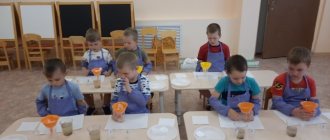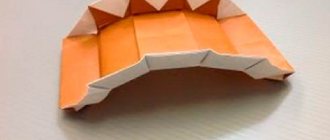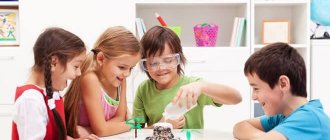Summary of experimental activities in the middle group “The Tale of Paper”
The professor brought us an envelope, what does it contain?Look, we have a fairy tale here, shall we listen?
Far away in a paper country they lived - there were Kartonych (a sheet of cardboard),
Leaflet (sheet of paper) and Fetochka (paper napkin).
And they had a dispute: “Who is more necessary and important among them.” They thought for a long time, and then they decided to find out everything on the journey.
And then on their way they met the Kitty. She wanted to play with the snow, but it was very cold. Friends offered their help to the cat.
Educator: Tell the guys: “How can I help the cat?
Experience: The guys try to make a snowball from three types of paper.
Experiment No. 1 » Let's crumple the paper
«
Invite the children to crumple paper, napkin and cardboard.
-Guys, was it easiest for us to crumple paper, napkin or cardboard? Why ?
Conclusion:
Paper snowball is the best. Cardboard is thick and difficult to fold. The napkin is very soft, tears quickly and does not hold its shape.
Experience No. 2 » Wrinkles, tears
«
— What happened to a piece of paper, cardboard, or napkin when we made a “snowball” out of it?
- What were they like before?
Now try to straighten our paper lumps.
— Has our paper become as smooth as it used to be?
You and I learned that paper wrinkles, but... does not straighten, does not smooth out.
I’ll tell you a secret, the paper can also rustle. Try to crumple the piece of paper and repeat after me the magic words: shi-shi-shi-paper rustle!
Listen now - is it rustling?
- Take our lump from a napkin and pull it in different directions.
- What happened?
- Was it difficult for you to tear the napkin?
Repeat with cardboard and paper.
- What did you do with the leaf?
Tell me, what was easier for you to tear cardboard, paper or napkin? Why?
Conclusion:
This means that thin paper breaks easily, it is not durable. Cardboard is durable and hard to tear.
The kitten said thank you. . Leaflet was proud that he helped.
The friends set off further on their journey, and they met a fox. She wants to drink from the stream, but does not know what to pour the water into.
Educator: Tell the guys: “How can I help the fox?
Guys, we can make a cup out of paper or a napkin or cardboard, but we need to find out which of this material can hold water better.
- Guys, what kind of water do we have, tell us about it?
-That’s right guys, the water is wet and that’s why you and I will now conduct an experiment and find out what kind of paper you have
It won't get wet for a long time.
Experiment No. 3 “Wet the paper”
Invite the children to wet the paper, napkin and cardboard.
Conclusion:
: A cardboard cup is the most convenient, thick, and does not let water through quickly. A glass made from a napkin and paper is not suitable, it gets wet quickly and leaks water.
The fox drank some water and said thank you and ran off into the forest. Kartonich is arrogant!
The friends set off further on their journey. They see a butterfly sitting on a stump and crying loudly, and its wings are stained with dirt. And because of this, she cannot take off, and the houses are already waiting for her.
Educator: Tell the guys: “How can you help a butterfly? (wipe the wings).
Experiment No. 3 “Let’s get some water wet”
Invite the children to wipe the stains on the table with paper, cardboard and a napkin.
- Guys, what was the most convenient way for you to wipe off the dirt? Why?
Conclusion
: The napkin is soft, wrinkles easily and wipes and absorbs better. Cardboard is rough and hard to wrinkle. Paper is less rough, but it is also inconvenient to wipe the table surface with.
Fetochka helped the butterfly put its wings in order. The butterfly thanked her and flew home. And Fetochka became proud, she is the most important.
The friends walked and walked through the mountains and forests, but they were never able to find out: “Which of them is the most necessary and important.” They walked, they walked, and met Professor Shar Sharych. He invited them to visit us. So that we help them. Let the children tell them why they are all very necessary and important to us.
Copy paper. Lesson notes on experimental activities (senior group)
Summary of the lesson on the experimental activity “Copy paper” Senior group Goal: To promote children’s understanding of the properties of carbon paper; Develop the ability to examine objects from different angles; Select material, continue the course of activity to obtain the desired result. Objectives: To introduce children to the properties of carbon paper
through experience; Develop the ability to organize your activities; Foster a sense of mutual assistance. Progress of the lesson. Educator: Guys, Dunno from Sunny City turned to us for help. In his letter, he writes that he has a lot of friends and he wants to invite everyone to his birthday. You need a lot of invitations and he won’t be able to draw for everyone. Let's help him. How can we invite friends? (call, send a telegram, an invitation card indicating the date, time, place). Educator: We don’t know how to write, but we need to make a lot of invitations and quickly. The guys who you wanted to invite (children's answers). Educator: But this will take a lot of time. How can we make it so that we can do a lot at once (children’s answers). Educator: There is magic paper with which you can draw several identical invitations, i.e. copy. This paper is called carbon paper. What is the name of this paper? (children's answers). Physical exercise. Let's raise our hands up - once above the nose, above the eyes. Keep your arms straight up, don't swing. don't tremble. Three - put your hands down, Stand still, don’t move around. Up one, two, three, four, down! We repeat, don’t be lazy! We will make turns. Do everything willingly. One - turn left, Two - now vice versa. So, without any haste, Repeat 8 times Educator: Let’s start the experiment. You have white paper, carbon paper, a paper clip, and pencils. Let's pick up carbon paper and study it. What is she like? Is it the same? Children's answers. Educator: One side is greasy with paint, the other is matte. Which side do you think should be used to place the copy on the sheet of paper on which the drawing is being transferred? Why? We need to get a copy, we will write on the matte side, and the paint on the bold side will be printed on the white sheet. The teacher shows. Educator: And if you need to make 3 copies, how many sheets should you take? You need to take 2 sheets of copy paper and 3 white sheets, i.e. there is always 1 more white sheet. To make the drawing clearly visible and have more copies, you need to press harder on the pencil. Now, using carbon paper, we will draw a lot of invitations. To do this, you have two sheets of white paper and one sheet of carbon paper. Place a white sheet, carbon paper on top, and another white sheet. Draw any design on the white top sheet. The children get to work. After finishing, consider what happened. Pay attention to who got two invitations, who got one on both sides. Children conclude that they need to take one more white sheet. At the end of the lesson, children exchange impressions:
- I am glad that I was able to help and make invitations.
- I was surprised that there were several postcards at once.
- It was very interesting to me.
- I was surprised when the copies turned out.
Let's take a blank invitation and color it. Let's draw conclusions about the benefits of carbon paper. Do you need it? Using carbon paper, you can make more copies in less time. Dunno expresses gratitude to you, now he can invite all his friends to the holiday.



